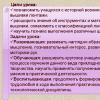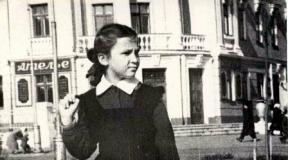Why does a child remember poorly? A child cannot remember letters A 5-year-old child cannot remember letters
We provide you with several recommendations that will help your child. remember the letters and easily move on to reading syllables. As well as games that you can play with your child at home.
Consultation for parents
“How to help your child remember letters”
At the initial stage of memorizing letters, it is better not to delve into the concepts of “sound-letter”. We need to talk about letters, pronouncing them with sounds: not “be”, but “b”, not “er”, but “r”. At the same time, pronounce them quickly and briefly. This way the child will quickly master the skill of merging sounds (letters) into syllables.
When learning letters, there is no need to use alphabets in which the letter is supported by only one picture, since when recognizing a letter, the child first remembers the picture, and then the name of the letter, and sometimes only the picture.
When coming up with words with a given sound with your child, name several words, not just one, so that he does not associate the letter with any specific object.
To practice isolating the first sound in a word, it is better to start with words where the vowels “a”, “o”, “u”, “e” are at the beginning and under stress (Stork, Donkey, Duck, Echo, etc.), after which you can try to isolate consonants not participating in the merging syllable (k-rot, t-ractor, etc.).
Games to help you remember letters
1. Game “Show the letter”
Draw the given letters using your fingers, palms and the whole body.
Lay out a letter from any material: laces, wire ribbons, counting sticks, mosaics, beads, buttons, matches, pebbles, pencils, noodles, sweets, dryers. You can also mold it from plasticine, salt dough, and draw with your finger and gouache on paper or on cereal, scattered on a tray in a thin layer.
2. Game “Find and name the letter”
Cut out letters from cardboard. Attach cardboard letters to various objects in the common room or the child’s room where you study with him. The principle of attachment is as follows: with which letter the name of the item begins, that letter is attached. For example: “cabinet” - “w”, “table” - “s”, “bedside table” - “t”, and so on. You can leave some letters of mom, dad, brother. For example: “Alla” - “A”, mom, “Kolya” - “K”, dad, draw portraits of relatives for these letters.
It is very useful to find objects in the environment that resemble letters, and also to complete the letters, “transforming” them. The letter “s” looks like a month, “o” looks like a hoop, and “p” looks like a gate.
You can find familiar letters in signs on the street, in books with large print.
3. Game "Architect"
Prepare cards from paper and draw the outline of a letter on each one with a pencil, and let the child color it. Cut each card into 2-4 parts and mix it, and ask the child to fold the letter and name it.
4. Game “Complete the letter”
An image is created for each letter. For example, for the letter “a” we add a pipe, doors, a window - we get “house”. Letters must be large.
5. Game “Find out the letter”
The child must recognize and circle the letters written in dots.
6. Game "What's Wrong"
The child finds letters in a row that are written incorrectly.
7. Game “Find and Underline”
Invite your child to find and underline (circle) a certain letter in the text. You can use unnecessary newspapers and advertising sheets for this game. The font should be large.
8. Alphabet darts game
Hang a poster on the wall - the alphabet. Throw a small ball at a certain letter and name it.
9. Game “Magnetic ABC”
You can attach it, for example, to the refrigerator and perform the following exercises: “Guess which letter”, “Which letter is missing?”, “Which letter is extra?”, “Which letter does the word begin with...”
10. Educational computer programs, cartoons, songs, poems about letters, bright alphabet books, coloring books also help remember letters .
Good luck to you!
Olkhovskaya Olga Ivanovna,
teacher-speech therapist, MBDOU "Kindergarten No. 66",
Kemerovo region, Prokopyevsk
- Attention deficit hyperactivity disorder
- How can I help my child prepare his homework?
Before entering school and during the first period of education, children often develop difficulties that parents did not pay much attention to before. After all, to successfully master the school curriculum, it is not enough to be a “good, obedient boy” or a “sweet, cheerful girl.” In addition to these wonderful qualities, one must also have special educational skills.
In the practice of child psychologists, a lot of requests are related precisely to the fact that a child, who previously completely satisfied his parents, turns out to be insufficiently prepared for school. This article provides some advice that is given to moms and dads in such cases. They will be useful to many parents who do not have the opportunity to receive individual consultation with a psychologist.
What to do if a child has difficulty learning poetry, if the kindergarten teacher or teacher complains that he does not remember the material she gives in class? Is it possible to develop children's memory?
In this case, you can achieve a lot by using special techniques for memorization. The most important of them is figurative representation what you need to remember, attracting a wide variety of associations. One of the techniques that helps to learn this is based on teaching the child to create drawings that reflect the material being learned. It is carried out like this.
The child is asked to “play an interesting game”:
I will tell you short stories, and you will remember them. In order not to forget anything, you will draw a simple picture for each such story.
Then several simple, unrelated phrases are given to memorize, for example: “The wolf ran out of the forest. The girl was given a doll. Kolya and Masha were playing in the yard. Yesterday it rained, and today the sun is shining.” After each phrase (“story”) there is a long pause so that the child has time to draw a picture to remember it. It is necessary to explain to him that the drawings should be as simple as possible, that there is no need to try to make them beautiful and detailed: this is not a drawing exercise, but a memory game. The main thing is to make the drawing quickly. If the child gets too carried away by the drawing process itself (and at first this is almost inevitable), then you should stop him by saying: “In my opinion, what you drew is already enough to remember. Now listen to the next story."
When creating your first drawings, you will need the help of an adult. Most likely, he will have to suggest their content and encourage the child to limit himself to an extremely schematic image.
How will we remember that it rained yesterday? Let's draw it and cross it out: after all, today it is no longer coming. But we won’t cross out the sun: it’s shining today.
The end result will be something like this:

You should not give more than three or four phrases in one lesson. You can remember them on the same day after a few hours or the next day. The child is given his drawings, and he “reads” the “stories” told to him from them. This may also require the help of an adult. For example, if he says: “The rain has stopped and the sun has come out,” then you need to ask him a leading question: “What did we say - when did it rain? That’s right, “it rained yesterday”... What next?” Regardless of how much help the child needed to correctly reproduce the phrases, you need to praise him: “See how well you remembered everything! This means that you have recorded all the stories well with drawings.”
It is advisable to conduct such classes daily or every other day, but no more than one lesson per day. After some time, drawings will no longer be necessary; it will be enough to discuss “what could be drawn to remember the story.” Thanks to such a discussion, the child learns to visualize the memorized material, which will greatly help him in the future at school.
If memory is poor, parents should be especially careful in selecting the material offered to the child for memorization. We must try to minimize its volume, achieving not verbatim memorization, but general understanding. In cases where verbatim memorization is still required, it must be done in small portions, ensuring that each portion is completely memorized before moving on to the next. For example, when memorizing a poem, it is convenient to learn it one quatrain (without trying to repeat the entire poem). However, before starting to learn, you need to discuss the development of the plot in detail with the child, so that later the quatrains do not change places.
How to help a disorganized, disorganized child? What to do if he doesn’t finish anything, starts and quits, doesn’t know how to concentrate, is inattentive?
With the complaints described, it is necessary to teach the child to plan his actions. It should become a mandatory but short stage preceding each action. “Tell me how you will do it” - with such sentences an adult can encourage the child to plan. It can relate to building from cubes (what to build, what building material will be needed for this), to putting away toys (what to put where, in what order), to drawing, making crafts from paper and scrap materials - in general, to any children's activities.
By highlighting a separate stage of planning as preparation for action, an adult must ensure that plans are implemented so that action is not replaced by its planning. The work must be completed. To increase the value of the results obtained, it is useful to attract the attention of others to them. Show other family members a structure built from cubes, hang an applique made by your child or his drawing on the wall, and attract the attention of friends who come to visit.
All organizational aspects of children's activities should be brought to automaticity. Such individual automatisms make it possible to identify islands of order in the general chaos of the behavior of a disorganized child. Where to start, which area of children's disorganization to streamline and automate first - preparing lessons, the morning ritual of getting ready for school or kindergarten, evening cleaning of toys - parents will decide for themselves. Just don’t grab everything at once and expect immediate results. Each individual automatism must be carefully practiced. A child who does not have self-organization skills needs first maximum, and then gradually decreasing help from adults. If it is always difficult for him to fulfill organizational requirements, then, consequently, they are too high: parents are in a hurry and show inappropriate impatience.
To develop organization and attention, you can offer special tasks aimed at learning sample analysis , correlating it with the result obtained, finding and correcting errors . Here, for example, is the task “Where Pinocchio went wrong”:
Malvina wanted to teach Pinocchio to draw beautiful patterns. She drew a pattern and told him: “Draw exactly the same.” But Pinocchio was distracted all the time, and he got it right and then wrong. Well, find where Pinocchio’s mistakes are and help him correct them.
Patterns might look something like this:

Similar tasks can be given on other materials. For example, another time Malvina may instruct Pinocchio to make a building out of cubes, or assemble a model from a “constructor”, or arrange pictures in a certain order (for this you need to have two identical sets of pictures), or make an applique. The habit of checking and correcting other people's mistakes will subsequently lead to the ability to check yourself, and this is the basis for paying attention to your actions.
A couple of years before entering school, parents, as a rule, begin to assess their child’s readiness for first grade. And then it turns out that the child, who was previously “like all children,” turns out to be restless, inattentive and does not remember new information well. Many parents make a grave mistake and begin to force their children to cram poetry, write letters and solve arithmetic problems. This approach does not produce results, and it creates a dislike for new educational information in the child.
Reasons
Before you start intensive training with your child, you need to figure out why he remembers poorly
Before you start intensive training with your child, you need to figure out why he remembers poorly. Child psychologists identify the following reasons:
- The kid is not used to finishing what he starts. As a rule, this happens if the child is not accustomed to independence and always hopes for help from adults in everything. If, while assembling a construction set, a grandmother finds a suitable part, then it is absolutely natural that the child hopes that she will learn the poem for him.
- Boredom. It’s not for nothing that boredom is considered a mortal sin. There is nothing more terrible for children than monotonous, monotonous activities of any nature. When a song learned in kindergarten just needs to be repeated, the baby will have no desire to remember the words. But if you invite him to sing it and play along with it using improvised means: spoons, rustling toys, or dance to it, the child will gladly join in the funny game.
- The desire to do “evil.” It also happens that children do not have good relationships in the family or team. Then they simply see no reason why they need to show their knowledge or skills. After all, it is known that the positive assessment of others is important to children, but its importance is determined by the fact that it is given by the people they love. And if the baby does not feel that he is accepted, then he will not try. However, this motive most often occurs in adolescent children.
This is interesting. Scientists have proven that a child is able to remember ten times more information than an adult.
- Low self-esteem. If a child is too shy, he may be afraid to repeat something so as not to be accused of inaccuracy or mistake. In a group of peers, he is afraid of being ridiculed. Therefore, such a mask: “I don’t remember” is a protection against a possible negative reaction from others. Also, a similar situation arises if parents constantly repeat to the child that he is doing everything ineptly, incorrectly or carelessly. By the way, psychologists have found that such an assessment does not play such a key role, unlike the intonation with which it was pronounced.
- Fear of comparison. When children begin to be compared with each other, this is a sure way to raise an envious egoist. A child is valuable for himself, and not because he is superior to his peer in some way.
How to help your baby develop memory?
The most important thing is to establish a trusting relationship
Having understood the reasons why a child does not remember new information well, you need to competently build a help strategy. Of course, the most important thing is to establish a trusting relationship. If the baby feels the support of his parents and loved ones, then his desire will be added to your efforts, and then any task can be accomplished. So, there are a number of techniques that make it easier to memorize the material:
Connecting the child’s imaginative thinking
- Connecting the child’s imaginative thinking. It is necessary to give the child the opportunity to graphically display what needs to be remembered. For example, sketch a story told by an adult. At the same time, immediately stipulate that the drawing does not have to be beautiful, it is a kind of memory card that will help you remember the plot later. Start with individual five or six short sentences, gradually moving to longer stories. Each subsequent lesson should begin with a retelling, using pictures, of what was heard in the previous lesson. At first, the child will be carried away by the drawing process itself, so adjust the time spent on drawing. Explain that this task is also about speed: the sketch needs to be done as quickly as possible.
- Selection of material. You should not take on large amounts of information; it is better to pay attention to high-quality memorization. Therefore, when memorizing poems, it is better to limit the number of lines per day, rather than try to cram it entirely. At the beginning of work on the poem, you should analyze the development of the plot so that the child does not subsequently change the lines.
- Planning. It is very important to teach your child to draw up a plan for his actions. This rule applies to any child’s actions: constructing with cubes, for example, may consist of comprehending the idea of construction, selecting building materials, and cleaning up toys after playing. Parents must ensure that the announced plan is implemented in the right sequence. It’s good if the results of the child’s work are appreciated by loved ones. For example, family and friends will see a structure built from cubes.
- Automation of actions. To develop attentiveness and organization in your child, teach him to create a schedule for his day. This way there will be enough time for both classes and games. Make this schedule in the form of a colorful poster, and refer to it as often as possible at first. Gradually, the baby will automatically follow a certain daily routine.
- Analysis training. Of course, any person needs to analyze information to remember. To teach your child analysis, you can play with him in the following way: offer to find errors in Pinocchio’s work, which Malvina instructed him to do. Let it be a pattern drawn on a sheet in which Pinocchio made inaccuracies. This way the child will learn to compare with a model and find mistakes, first in the actions of others, and then in his own.
The form of this memorization technique is suitable for children of any age. Only the content will change. The main thing is to show the child that you sincerely want to help him. And his success is important to you much more than excellent grades at school.
Many parents sometimes face the problem that their children cannot remember the alphabet. In this article we want to tell you how to solve this problem.
Teaching a child letters is not as difficult as it might seem at first glance. Due to the fact that young children are very restless and cannot concentrate on one lesson for more than 5 minutes, you will need to prepare tasks with letters in such a way that the child remains interested and has some understatement, which will subsequently encourage him to further study the letters of the Russian alphabet. Each of your lessons should take place in a game that is colorful, bright, fast and creative, then your baby will quickly learn letters. You should also take into account the age of the child, if the baby is from 1 to 2 years old, then accordingly you need to prepare tasks designed for this age, if the baby is older, then the tasks should accordingly be longer and more creative. It has already been proven by experts that all children aged 0 to 3 years have an intensive brain growth; during this period, photographic memory is very well developed, so he can remember everything as a picture, so during this period you can easily teach your child letters.
Start with – You can choose one of the example songs I have given for children about the alphabet. Everything is always easier to remember in it. Songs last no more than 1 minute and are always easier to learn with cheerful music. You will see how soon your baby will hum the melody from this song himself, and most importantly, learn the names and sequence of letters in the Russian alphabet. Very good - you can download it and use it, for example, on the road or just turn it on during the day. It is designed for ages from 1 to 5 years.
Learning letters
Games to help you learn the letters of the Russian alphabet
House of Sounds This game will help you identify all the sounds in words of three to five sounds. You draw a house with three windows and explain to your child that names live in the house. Each apartment has a sound tenant. The CAT went to his house. He has three rooms. Each sound sleeps separately. We need to put the cat to bed. Who sleeps in the first bedroom? You give the child a chip the size of a house window: “This is a sound. Call him to sleep.” The kid calls: “K-K-K” - and puts the chip in the first room, etc. If a child “loses” the second sound and “catch” the sound T with the second chip, you are surprised: “Does KT live here? I thought KOOT lives here!”
Playing Dr. Zvukov “I am Dr. Zvukov,” you announce to the child, putting on a white cap or something similar, “if your dolls have not learned to pronounce any sounds, I will cure them.” Tanya,” you turn to the doll, “say: “A large grapevine grows on the Arrrrrrat mountain.” And burr for Tanya: “On the gollle Allallllat lllast kllupny winelllad.” Your daughter does not pronounce R. I prescribe her medicine: name ten words starting with R and five words ending with R. You can suggest the words yourself or send a “nurse”. The child (in the role of a nurse) is in charge of Tanya, and she gradually recovers. You should play only if your baby does not burr himself.
The need for a hard sign in the Russian alphabet is now not disputed by anyone. After all, it performs very specific functions, for example, it separates the consonant of the prefix from the vowel of the root in words such as congress and eat. And before the reform of 1917-1918. it was called “er” and was written at the end of words after a hard consonant, without carrying any special semantic load. However, it took up more than 8% of printing time and paper and cost Russia more than 400,000 rubles annually. Modern man is nowhere without the alphabet. Not only because without these sticks, rings and hooks there will be no writing (no newspapers, no books, no - what a nightmare! - the Internet). But also because we are too accustomed to expressions like “from A to Z” or “Z is the last letter in the alphabet,” and replacing it with something like “Z is the last letter in the alphabet” will not work.

How to learn letters with your child for a long time
We bought a CD for ABCDeyka for ours, we turn it on every day for a few minutes and she learned almost all the letters without our participation. There is also an alphabet with pictures, from the pictures she has also already figured out which letter begins with which word. The main thing is that the child himself wants it. Ours is 4 years old.
In a playful way, the child needs to be shown how letters form syllables. When he learns to read all possible combinations, then explain to him how syllables are combined into words. Examples should consist of words that are familiar and understandable to the child. At the same time, you can start showing him how to write block letters. Sometimes, it is difficult for children who already know how to read what their mother wrote to read printed text, so learning should be parallel. In the future, for learning it is better to use children's books with short fairy tales, where the words are divided into syllables and there are a large number of pictures. However, as soon as the child understands the essence of reading syllables, then switch to reading a regular book (necessarily with pictures) and continue learning further. Otherwise, the child will have problems reading words that are not broken down into syllables. The main thing is that the child is interested and does not get overtired, then he will have a constant desire to read something. And do not forget to praise your baby - this is the most important incentive for him. As for perseverance, then everything is fine with your child. Even first-graders cannot concentrate their attention for more than 15 minutes - this is normal. Practice for 10-15 minutes, praise her several times a day and tell her how happy her dad or grandparents will be when she writes or reads something to them.
Beautiful letters for Russian classmates
The mistake of many parents is when they start teaching letters, but they should learn sounds (not Be, but the sound B, etc.) Try to explain this to the child that there is a letter, but there is a sound and the sound is different. When reading, we read with the help of sounds, a pair of sounds is a syllable that we read: first we name the sounds separately (BA - sounds B and A, BA-a). A few training exercises and the child will understand.
If you want to develop a child, then develop according to age, taking into account psychophysiological development. Colors (up to 3 must know all the basic ones), Animals (classification - wild or domestic), Ability to retell a fairy tale, Tell a story using pictures, and many others. A child must first understand the diversity of the world around him, and only then learn to read about it. For him, any reading is like reading Hamlet at 6 for you. Why bully a child? The ability to read is by no means an indicator of the development of a child’s intelligence and personality.
Everything should be gradual. The child will learn to read. Mine also knew half the letters by the age of 2, but now he is not interested in learning them. I don't insist. Why burden the child? We need to teach him self-service skills. And all this early learning leads to neuroses. He will go to school and learn to read. In general, in order for a child to read, the family must read. Organize family readings, role-based readings.
We learned to read from Zhukova’s ABC book, it was an ideal book, all the friends we gave it to quickly started reading it. So, on the very first page, the author ADVISES that you should under no circumstances learn all the letters with your child at once; this should be done gradually. And she also has this picture, it kind of helps the child visually imagine the path from one letter to another and learn to pronounce them together, and not separately. Pointing with a pencil to the first letter, ask the child to draw the first letter until you with the boy you will not reach the second path along the path.

Beautiful Russian letters for children - preschoolers
Until the age of 4, this is not necessary; it is better to teach colors, animals, plants, and the surrounding world; the child will not be able to perceive both. And in general, I think that it’s easier to learn according to Glen Doman’s system; you learn words instead of letters.
Let's move on to letters When showing your child a letter, call not its “official” alphabetical name, but the sound that it stands for. Try to sing this sound, draw it out, as long as possible, both when showing the letter and when pronouncing words with this letter. When entering a letter, name as many words as possible that begin with the corresponding sound. Give your child only printed examples of letters - they will teach him how to write them at school. He will remember the letter easier if he tries to draw it or lay it out from sticks, or draw it on the snow or sand.
The most important rule that parents must learn is to build learning according to the principle from sound to letter. A letter is a sign of sound. Introducing a letter sign will be ineffective if the child does not know what exactly it means. In order to learn to read and write, a child must discover that any word consists of sounds, and only then “understand the relationship” of sound and letter. The sound training period does not last long: three to four months. At the same time, a child can learn letters already in the second month of classes. But let the training take place in the form of a game, and not an “obligatory” task, with grades given for academic performance. The baby should enjoy learning sounds and letters. And if you manage to maintain the theme of the game for ten to fifteen minutes, this indicates the effectiveness of your teaching efforts. We offer you several games that will help your child learn to distinguish sounds in a word by ear.
Most psychologists believe that teaching children to read too early (before three years of age) can lead to distortions in the child’s development. The best time is when the baby is already four or five years old and has learned to speak well. This, of course, does not mean that a child should construct phrases like an adult. He may also have a lisp and burr, may not pronounce long, complex words, and sometimes may not agree on cases. If the child started talking quite late - by the age of three - or has serious pronunciation defects, a poor vocabulary, speaks in short sentences and does not use prepositions at all, does not change words by case - it is better not to rush into learning to read.
Even in the case of poor preparation for school, a child who does not know letters and cannot read, with normal intellectual development, will gradually catch up with his peers. But when, during regular practice, a child is not able to remember and name letters already familiar to him, confusing them with each other, this may be the result of serious deviations. To determine further tactics, parents need to find out exactly what developmental features are preventing their child from coping with learning.
Causes associated with developmental disorders
Difficulties in learning letters may be associated with delayed mental and speech development caused by impaired blood supply to the cervical spine. This is typical for birth injuries and can appear when a first-grader begins his education. Parents and teachers should pay attention to the following characteristic symptoms:
- increased mobility;
- fatigue;
- child's complaints of headache and nausea;
- tearfulness.
Functional disorders of the body caused by other factors can only be detected through special examinations. These disorders, many of which are associated with abnormalities in the development of the central nervous system, include:
- low degree of visual perception and poor visual memory;
- difficulties with orientation in space, when the child confuses the directions “right” - “left”, right and left arm/leg;
- late redistribution of mental functions between the cerebral hemispheres;
- consequences of retraining left-handers;
- underdeveloped auditory perception, making it difficult to establish a connection between the spoken sound and the letter;
- disturbances in behavior (cannot concentrate, gets tired quickly) and motivation (constantly prefers games to activities).
In case of serious problems, you cannot do without consulting a neurologist. After the examination and diagnosis, the doctor will give recommendations to parents and, if necessary, prescribe appropriate treatment, including the use of medications.
Exercises to correct disorders
Thanks to regular exercises with a problem child, which complement the neurologist’s prescriptions, it is possible to eliminate most speech pathologies that impede the development of reading and writing skills. Classes will help to correct visual perception, attention and learning motivation, as well as to develop the right-to-left orientation skill, which should be developed in a child before entering school. The following exercises are suitable for this:
- Constant practice of words: right, left, left, right. Remind in any situation, for example, when a child picks up an object (spoon, pencil, scissors).
- When reading fairy tales, ask questions about illustrations and pictures in books: “What (who) is on the top right, bottom left?” etc.
- Development of fine motor skills with finger exercises.
- Graphic dictations (image of a figure on a checkered sheet, following oral explanations). For example, ask to draw segments diagonally to the right down 5 cells, to the left up 2 cells.
- Making letter signs that the child can look at if necessary. On one of them there should be letters facing to the left (L Y Z U E CH), on the other – to the right (B V G K R S Ts SCH Y Ъ YU E).
- Making a comparison between two similar letters, such as “N” and “P”, or “N” and “I”.
- Using the alphabet in verse to teach (for example, with the poems of S. Marshak: “A bear found honey in the forest / Little honey, many bees”) gives an effective result; associations speed up memorization.
Memory development
If the child does not have neurological abnormalities, the most common reasons for poor memorization of letters are insufficiently formed and poorly developed memory, logic and attention. In this case, activities that improve these mental functions will help.
To train memory and observation skills, it is good to involve your child in useful games:
“What’s missing?”
Place several toys in a row, naming them out loud. Cover them with a scarf for a few seconds, remove the scarf along with one of the toys and ask the child to name the missing one. Repeat 4-5 times. In the future, toys can be replaced with letters.
"Sherlock Holmes"
It is necessary to determine what has changed in the person’s appearance (for example, an item of clothing, glasses, a hat has disappeared/appeared). Another option is to periodically ask the child what his friend, teacher, etc. was wearing.
Learning quatrains
This should be done daily, and for better memorization, accompany the poems with figurative pictures, drawing them together by hand.
Visual images of letters
There are various ways to memorize the visual image of letters. The sequence of actions could be like this:
- For three days you need to study one of the letters with your child. It should be everywhere, so in addition to persistence, you will have to show creative thinking.
- Hang up sheets of paper with the letter you are studying in your apartment so that they are in front of your eyes in every room.
- Fashion a letter from various materials (plasticine, dough, wire), cut it out of colored paper, make it from colored ropes, branches, draw on asphalt or sand.
- Write the letter on paper. Ask the child to trace it along the contour with a glue stick. Then glue any small grains (for example, buckwheat). Let the baby feel the resulting three-dimensional silhouette, reinforcing the visual image with tactile sensations.
- Draw a letter on the baby's palm. This should be done on the dominant hand to stimulate the dominant hemisphere.
- Use soft puzzles with letters. The child feels them with his eyes closed, and other channels of perception are activated.
- Ask your child to find and circle (cross out) the letter being studied among many others on a page in a newspaper or magazine.
- Give a task during which the child is asked to group identical letters presented in different font styles.
- Ask to find the letter in surrounding objects on the street: on signs, advertising, in a store.
- Together with your child, draw a letter using your hands and feet; you can use additional objects.
Writing letters in the air with the index finger of your dominant hand is helpful. It would be a good idea to switch roles: the child writes, the adult guesses, and vice versa.
You can suggest adding a letter along the dotted line or converting one into another by moving the counting sticks, for example, from “Sh” to make “C”.
Many speech therapists use a game called “Magic Bag” in their classes. Letters (plastic or metal) are placed in the bag, and the child must determine by touch which one he gets. If he guesses correctly, he gets points. If not, the letter is put back.
Putting out small words gives good results. Then the letters can be rearranged, “lost” them from the words and asked the child to restore them.
For a visible positive result, it is necessary to carry out constant work with the child. You need to praise your child for his efforts and under no circumstances compare him with other more capable children. The main thing is not to forget that all joint activities should be carried out in a playful way and only on positive emotions, bringing pleasure to both the adult and the child.



















